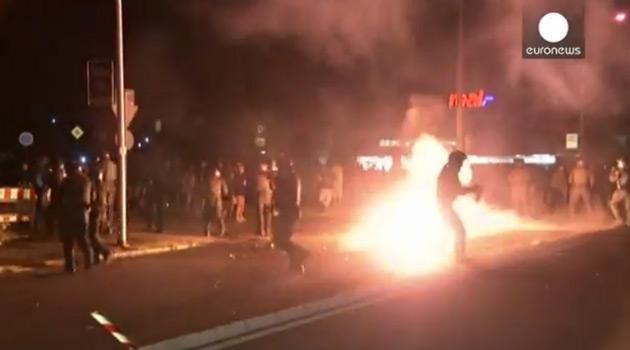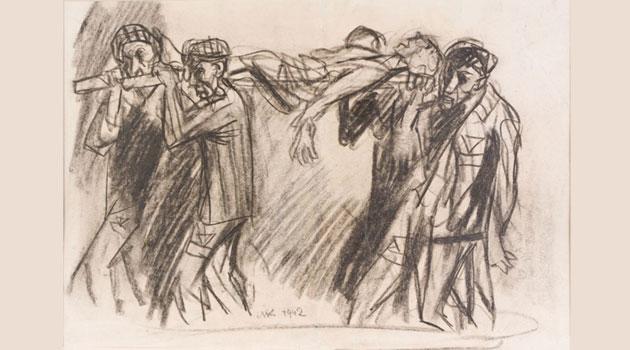Germany: Romani-inhabited building struck by arson, media strangely quiet

Dozens of residential buildings have been struck by arson in Germany in recent years, and the subtext to these insidious attacks has been either a neo-Nazi motivation, or a racist one, or has yet to be identified. Fortunately, the victims of most of these cases have not suffered physical injury, as the targets have been residential hotels slated for accommodating refugees that were not yet occupied at the time of the crime.
For that reason, it is an open question why neither the German media nor the international media has spent much time reporting on a similar crime from the close of 2017 that has caused several persons, including a young child, serious injuries with permanent consequences. Why would this be?
The case at issue happened in the center of a district town, Plauen, in southwestern Saxony (near the Czech town of Aš) just before midnight on 29 December 2017, when a fire broke out in the basement of a five-storey tenement house and rapidly spread along the staircase. The flames and the smoke prevented any easy escape for the inhabitants, who first woke each other up and then attempted to get their children and wheelchair-bound neighbors to safety.
One neighbor gives a Nazi salute to the fire, others aid the victims
A police patrol was soon at the scene, as were two youths who were randomly driving by. They jumped out of their car and began to aid the residents with bringing down the children who were being lowered or even had to be thrown by the adult residents before several firefighting vehicles arrived.
The rest of the inhabitants fled the burning building by climbing down the firefighters’ ladders. The two youths told the German press that some of the neighbors from other residences next to the burning building came out onto the street and shouted racist abuse at the victims – one, for example, called on the rescue workers to let the building burn with its inhabitants and gave a Nazi salute.
Other neighbors, on the other hand, brought the injured people blankets, clothing and food. Plauen is the biggest town in the Vogtland area, with a population of approximately 60 000.
At the beginning of October 1989, roughly 20 000 people in Plauen protested in the streets against the then-communist regime of East Germany. In recent years it has become a front-line town in both the antifascist movement and the movement against refugee reception in Germany.
Police have had to deal with strong clashes between those advocating either side of those issues. On 1 May 2014 the biggest neo-Nazi demonstration in the entire country took place in Plauen, attended by guests from Finland and Hungary, and the two main, well-organized blocs of demonstrators involved activists from Bavaria and Saxony.
Those opposed to racism successfully blockaded the neo-Nazis at a certain point in their march that year. After the neo-Nazi NPD party went bankrupt, the biggest support among local neo-Nazis there has gone to a new party called The Third Way (Der dritte Weg).
Currently the Bavarian Green Party is the main entity striving to get The Third Way banned. In 2017 several arson attacks were committed in Plauen, most of them against abandoned buildings where homeless people sometimes slept.
All of the victims of this most recent attack survived the blaze and were taken to hospital by ambulance. The German website Belltower, which has long reported on neo-Nazism and racism in Germany, reported the news.
Four victims suffered serious injuries but are no longer in danger of losing their lives. They include two children aged two and five and two women aged 29 and 39.
Seven more persons aged 1 – 29 were, according to police, under doctors’ care for several days after the incident. Some of the families have been split up, according to the German media – for example, one mother is in a special clinic for burns in Leipzig while her infant, who suffered facial burns, is in a similar hospital in Dresden.
Two firefighters also suffered slight injuries during the incident. Thanks to their intervention, the blaze was suppressed before it could spread to the neighboring buildings, but the structure that was attacked is of course uninhabitable now and its occupants have taken refuge in various emergency quarters.
Police were clear from the start
The day after the blaze, police arrested a local resident who used to live in the building. According to other locals the man had owed back rent, argued with the owner, and had recently moved out.
On the basis of a court ruling the suspect was remanded into custody. According to the prosecutor, no evidence has yet been discovered as to a racist motivation for this attempted murder and battery.
Nevertheless, the investigators say they are pursuing all possible motives for the crime and not ruling any out. Police say the suspect is not talking.
If the suspect has not confessed, then how were police able to find evidence of his guilt in just a few hours? The prosecutor is saying this was a crime committed by a single perpetrator, but the residents of the building are convinced there were multiple perpetrators.
Two inhabitants of nearby residences have also been charged with assaulting a public official, battery and defamation. Several days after the blaze, the locals were caught attempting to steal the victims’ property from the burned-out building.
The German daily Freie Presse has reported that in recent days police in Plauen have had to intervene again in the neighborhood. According to some arson victims who were temporarily accommodated nearby, three men were caught in the basement of their new dwelling with bottles in their hands, allegedly preparing another attack.
When the Roma asked the men what they were doing, they rapidly fled. The same men had allegedly been seen just before the blaze broke out at the Romani victims’ previous home.
Police have not yet announced whether they are looking for the suspects and have reportedly not publicized any descriptions of them. The building that was attacked on 29 December was mainly inhabited by Roma from Romania and Slovakia in addition to local Germans. The foreign nationals are not refugees, but immigrant families from other EU Member States. That may be one reason why neither the German, nor the Romanian, nor the Slovak mainstream media have decided to focus attention on this case.
